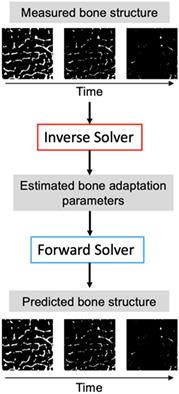当前位置:
X-MOL 学术
›
Int. J. Numer. Method. Biomed. Eng.
›
论文详情
Our official English website, www.x-mol.net, welcomes your feedback! (Note: you will need to create a separate account there.)
An inverse technique to identify participant-specific bone adaptation from serial CT measurements
International Journal for Numerical Methods in Biomedical Engineering ( IF 2.1 ) Pub Date : 2021-07-27 , DOI: 10.1002/cnm.3515 Tannis D Kemp 1, 2, 3 , Bryce A Besler 2, 3 , Steven K Boyd 1, 2, 3
International Journal for Numerical Methods in Biomedical Engineering ( IF 2.1 ) Pub Date : 2021-07-27 , DOI: 10.1002/cnm.3515 Tannis D Kemp 1, 2, 3 , Bryce A Besler 2, 3 , Steven K Boyd 1, 2, 3
Affiliation

|
Simulated bone adaptation is framed as an interface evolution problem. The interface is extracted from a high-resolution computed tomography (CT) image of trabecular bone microarchitecture and modified by the level set equation. A model and its parameters determine the bone adaptation rate and thus the bone structure at any future time. This study develops an inverse problem and solver to identify model parameters from multiple high-resolution CT images of bone within the level set framework. We demonstrate the technique on a model of advection and mean curvature flow, termed curvature-driven adaptation. The inverse solver uses two CT scans to estimate model parameters, which map the bone surface from one image to the next. The solver was tested with synthetic images of bone changing according to the curvature-driven model with known model parameters. The algorithm recovered known model parameters excellently (R2 > .99, p < .001). A grid search indicated that the estimated model parameters were insensitive to hyper-parameter selection for learning rate 1e−5 5e−5 and gradient scaling factor 5e−5 5e−4. Finally, we tested the algorithm's sensitivity to salt-and-pepper noise of probability , where .0 .9. Model parameter accuracy did not change for < .7, corresponding to Dice coefficients greater than .7. The inverse problem estimates bone adaptation parameters from multiple CT images of changing bone microarchitecture. In the future, this technique could be used to determine participant-specific bone adaptation parameters in vivo, validate bone adaptation models, and predict bone health.
中文翻译:

从连续 CT 测量中识别参与者特定骨骼适应的逆向技术
模拟骨骼适应被定义为一个界面进化问题。该界面是从骨小梁微结构的高分辨率计算机断层扫描 (CT) 图像中提取的,并通过水平集方程进行修改。模型及其参数决定了骨骼适应率,从而决定了未来任何时候的骨骼结构。本研究开发了一个逆问题和求解器,以从水平集框架内的多个高分辨率骨骼 CT 图像中识别模型参数。我们在平流和平均曲率流模型上演示了该技术,称为曲率驱动适应。逆求解器使用两次 CT 扫描来估计模型参数,这些参数将骨骼表面从一个图像映射到下一个图像。根据具有已知模型参数的曲率驱动模型,使用骨骼变化的合成图像对求解器进行了测试。该算法很好地恢复了已知的模型参数(R 2 > .99,p < .001)。网格搜索表明估计的模型参数对学习率 1e -5 的超参数选择不敏感 5e -5和梯度缩放因子 5e -5 5e -4。最后,我们测试了算法对概率椒盐噪声的敏感性, 其中 .0 .9. 模型参数精度没有变化< .7,对应于大于 .7 的 Dice 系数。逆问题从改变骨微结构的多个 CT 图像估计骨适应参数。将来,该技术可用于确定参与者特定的体内骨骼适应参数、验证骨骼适应模型并预测骨骼健康。
更新日期:2021-07-27
中文翻译:

从连续 CT 测量中识别参与者特定骨骼适应的逆向技术
模拟骨骼适应被定义为一个界面进化问题。该界面是从骨小梁微结构的高分辨率计算机断层扫描 (CT) 图像中提取的,并通过水平集方程进行修改。模型及其参数决定了骨骼适应率,从而决定了未来任何时候的骨骼结构。本研究开发了一个逆问题和求解器,以从水平集框架内的多个高分辨率骨骼 CT 图像中识别模型参数。我们在平流和平均曲率流模型上演示了该技术,称为曲率驱动适应。逆求解器使用两次 CT 扫描来估计模型参数,这些参数将骨骼表面从一个图像映射到下一个图像。根据具有已知模型参数的曲率驱动模型,使用骨骼变化的合成图像对求解器进行了测试。该算法很好地恢复了已知的模型参数(R 2 > .99,p < .001)。网格搜索表明估计的模型参数对学习率 1e -5 的超参数选择不敏感 5e -5和梯度缩放因子 5e -5 5e -4。最后,我们测试了算法对概率椒盐噪声的敏感性, 其中 .0 .9. 模型参数精度没有变化< .7,对应于大于 .7 的 Dice 系数。逆问题从改变骨微结构的多个 CT 图像估计骨适应参数。将来,该技术可用于确定参与者特定的体内骨骼适应参数、验证骨骼适应模型并预测骨骼健康。


























 京公网安备 11010802027423号
京公网安备 11010802027423号